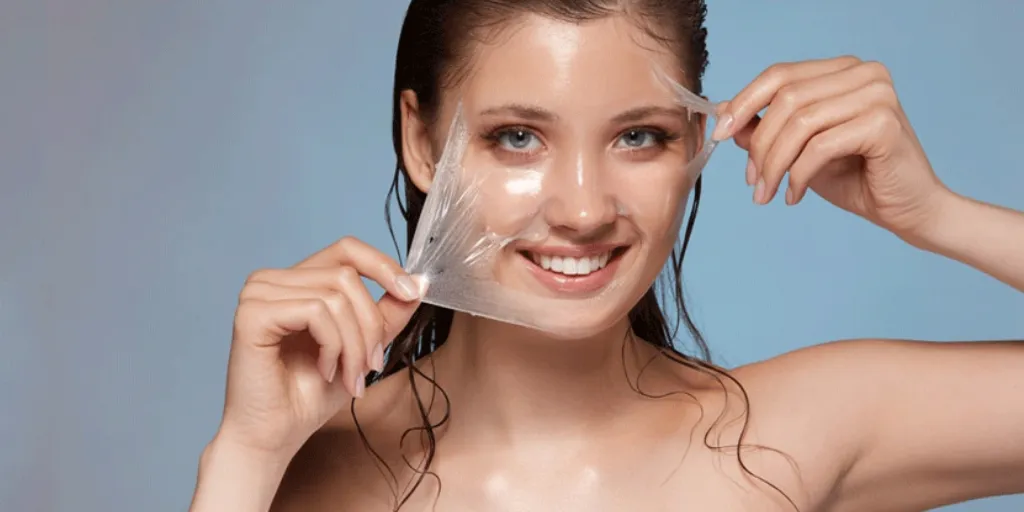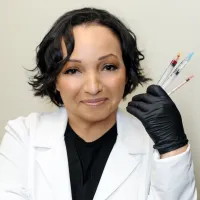BLOG

Chemical Peels vs Facials
Chemical Peels vs. Facials: Which One Does More for Your Skin?
If your skin’s been feeling dull, uneven, or just “blah,” you’ve probably wondered, “Should I get a facial or a chemical peel? ”
Not sure whether your skin needs a facial or a chemical peel? You’re not alone. Both treatments are popular for refreshing tired, dull, or uneven skin—but they work in very different ways. Facials focus on hydration, balance, and relaxation, while chemical peels dive deeper to correct concerns like acne scars, pigmentation, and fine lines. Knowing which one is right for you depends on your skin type, goals, and how quickly you want results.
As a licensed esthetician here in Suffield, CT, I get this question almost daily. Both facials and chemical peels can give your skin a reset—but they work in different ways. Knowing which one is right for you depends on your skin type, your goals, and even your timeline.
Let’s break it down clearly so you’ll know when to book a facial, when a peel is the better choice, and why sometimes the answer is… both.
What is a facial?
A facial is a hands-on skin treatment designed to cleanse, hydrate, and balance your skin. At my studio, no two facials are ever the same—I customize every one based on what your skin needs that day.
Typical steps in a custom facial include
Double cleanse
Exfoliation (enzyme, scrub, or gentle peel)
Extractions (if needed)
Mask + massage
Finishing serums and SPF
Best for: hydration, relaxation, routine maintenance, and gentle glow.
Read more about Custom Facials in Suffield, CT.
Types of Facials and How They Compare to Peels
Facials aren’t one-size-fits-all—each style has its own strengths.
Hydrating facials: Replenish dry, tight, or flaky skin.
Anti-aging facials: Target fine lines with massage and antioxidant serums.
Acne facials: Deep clean congested pores and calm breakouts.
Teen facials: Gentle, educational treatments for younger clients.
Compared to peels, facials are more about maintenance and comfort, while peels push for deeper correction.
What is a Chemical Peel?
A chemical peel is a professional exfoliation treatment that uses safe acids (like glycolic, salicylic, or TCA) to dissolve dead skin cells and stimulate cell turnover.
Depending on the type, peels can be:
Light peels: mild refresh, little to no downtime
Medium peels: deeper correction, a few days of flaking
Medical-grade peels: stronger results, longer recovery
At my studio, I offer PCA Peels, Perfect Derma Peels, Glycolic Peels, and Bright & Even Peels—each matched to your skin story.
Best for: acne, scars, pigmentation, aging signs, and long-term skin correction.
Learn more about Chemical Peels in Suffield, CT.
Safety Consideration: Who Should Avoid Each?
Not every treatment is safe for everyone—that’s why consultation is key.
Facials may not be ideal if you have:
Active skin infections or open wounds
Severe eczema or uncontrolled rosacea flare-ups
Recent aggressive cosmetic procedures
Chemical peels may not be safe if you’re:
Pregnant or breastfeeding (some acids aren’t recommended)
Taking Accutane (within the last 6–12 months)
Recently sunburned or tanning frequently
Struggling with active cold sores or infections
Key Differences Between Peels and Facials
Both facials and chemical peels have their place—it just depends on your goals. Facials are perfect for monthly upkeep and instant glow, while peels dive deeper to correct concerns like acne, pigmentation, or aging. Many clients even alternate the two for balanced skin health.
What Clients Notice First
Facials:
Immediate hydration and softness
Reduced redness and calmer skin
That healthy, “just-glowed-up” feeling
Chemical Peels:
Brighter skin tone after a few days
Smoother texture as flaking subsides
Fading pigmentation and fine lines with multiple sessions
Which One Is Better for Acne?
Facials: Great for calming active breakouts, unclogging pores, and reducing redness. Perfect for teens or sensitive skin.
Chemical Peels: More effective for ongoing acne issues, scars, and preventing future breakouts. Pairing peels with Blue LED light therapy boosts results even more.
See my Acne & Skin Rejuvenation treatments in Suffield, CT.
Which One Is Better for Anti-Aging?
Facials: Hydrate, plump, and temporarily soften fine lines. Excellent for regular upkeep.
Chemical Peels: Stimulate collagen, smooth rough texture, and fade fine lines + wrinkles over time. Red LED therapy can be added for extra collagen support.
Which One Is Better for Pigmentation and Dark Spots?
Chemical peels win here.
Peels lift away discolored cells and brighten tone. They’re especially helpful for:
Sun damage
Post-acne marks
Pregnancy-related melasma
Facials can brighten overall tone but won’t fade deep pigmentation the same way.
Facials vs. Peels for Sensitive Skin
Sensitive skin needs special care.
Facials: A safe, soothing choice. Customized with calming masks, hydrating serums, and LED light.
Peels: Require a careful approach. Lactic acid or mandelic acid peels are gentler, but deeper peels may cause irritation.
Which One Works Faster?
Facials: Immediate glow and hydration, but results fade in a few days.
Chemical Peels: Results build gradually over a series, but changes are deeper and longer-lasting.
Think of facials as your weekly workouts and peels as your intensive training sessions. Both matter—just in different ways.
Long-Term Benefits: Glow Correction
When it comes to skin care, some treatments are about keeping your skin healthy day-to-day, while others are about creating deeper transformations. Facials and chemical peels balance each other beautifully in this way.
Facials: Your Steady Partner
Facials provide ongoing maintenance. With regular treatments, your skin stays hydrated, balanced, and resilient against environmental stressors like pollution or seasonal dryness. They also help prevent future issues by keeping pores clear, improving circulation, and supporting your skin barrier. Over time, this consistency means fewer flare-ups, less sensitivity, and a healthier overall complexion.Chemical Peels: Your Big Change-Maker
Peels dive deeper to target specific concerns that facials alone can’t fully address. Through controlled exfoliation, chemical peels trigger cell turnover and stimulate collagen, which helps smooth fine lines, fade stubborn pigmentation, and reduce acne scarring. With a series of treatments, clients often see long-lasting improvements that go beyond surface glow — it’s true skin correction.
The Magic of Both Together
Think of it this way: facials keep your skin looking fresh and radiant every month, while peels provide those milestone improvements that make your skin look years younger, clearer, and more even. Combined, they create a long-term strategy for skin health that balances prevention with transformation.
Seasonal Skincare: When to Book Facials vs. Peels
Timing matters when planning treatments.
Facials: Safe year-round. Great for summer glow-ups or hydration in winter.
Chemical Peels: Best in fall and winter, when UV exposure is lower. This reduces risks of hyperpigmentation and helps repair summer sun damage.
Downtime and Lifestyle Planning
One of the biggest deciding factors for clients is, “How soon can I get back to normal? ”
Facials:
Zero downtime
Makeup can be applied right away.
Perfect for same-day events
Chemical Peels:
Light peeling/flaking for 2–5 days
It's best to avoid makeup until skin heals.
Plan at least 1–2 weeks before major events.
Cost and Downtime Comparison
Facials: $100–$150, no downtime.
Chemical Peels: $150–$300 depending on depth, may cause mild flaking for 2–5 days.
At-Home Skincare After Facials vs. Peels
Post-treatment care makes a big difference in results.
After a Facial:
Use a gentle cleanser and hydrating serum.
Apply SPF daily to protect your glow.
Avoid heavy exfoliation for 2–3 days.
After a Chemical Peel:
Stick to mild, non-active cleansers.
Use soothing, fragrance-free moisturizers.
Avoid retinol, acids, and scrubs until peeling ends.
Apply broad-spectrum SPF daily (non-negotiable!).
Can You Combine a Facial and Chemical Peel?
Yes — and in many cases, combining the two is the best way to get maximum results without over-stressing your skin. While facials and chemical peels each bring their own benefits, layering them strategically can address multiple concerns at once.
Here’s how it works:
Step 1: Facial Prep
A facial hydrates, soothes, and balances your skin before introducing active ingredients. Think of it as setting the stage so your skin is calm and ready.Step 2: Chemical Peel Boost
Once your skin is prepped, the peel goes to work—exfoliating deeper layers, resurfacing rough texture, and correcting issues like acne scars, pigmentation, or fine lines.Step 3: Add-On Therapies
LED light therapy or targeted serums can be added afterward to encourage collagen production, reduce redness, and speed up recovery.
Why clients love this combo:
Faster visible results
Balanced approach (hydration + correction)
Reduced irritation compared to peels alone
Works for events (facial first) and long-term change (peel series)
It’s like pairing a great workout with the right recovery routine: the facial nourishes your skin while the peel challenges it to regenerate and renew. Together, they create a glow that’s both immediate and lasting.
Facials vs. Peels for Men's Skin
Yes, men benefit just as much as women—sometimes more.
Facials for men:
Deep-clean oilier skin.
Reduce ingrown hairs from shaving.
Balance rougher skin texture.
Chemical peels for men:
Target acne scars from teen years.
Minimize sun damage (common for golfers and outdoor workers).
Brighten uneven skin tone.
Frequently Asked Questions
How often should I get a facial?
Most clients benefit from facials every 4–6 weeks for consistent hydration and skin maintenance.
How often should I get a chemical peel?
Depending on peel strength, every 4–8 weeks. A series of peels usually delivers the best long-term results.
Do facials or peels hurt?
Facials are relaxing and soothing. Chemical peels may cause tingling or warmth, but discomfort is minimal and temporary.
Can I wear makeup right after?
Yes, after a facial you can apply makeup immediately. After a chemical peel, it’s best to wait until flaking has subsided (2–5 days).
Which treatment is better before a big event?
Facials are best if you need an instant glow the same day. Peels require downtime, so schedule them at least 1–2 weeks before major events.
Can facials and peels be combined?
Absolutely! Many clients start with a facial to hydrate and calm the skin, then add a peel for deeper correction. Pairing both can maximize glow and results.
Finding Your Best Skin Reset
Both facials and chemical peels have an important place in skin care—one gives you instant hydration and glow, while the other delivers deeper correction and long-term change. The right choice depends on your skin type, goals, and lifestyle. Some clients love the regular refresh of facials, others prefer the transformative results of peels, and many benefit from a mix of both.
If you’re unsure which path to take, I’m here to guide you. Together, we’ll create a treatment plan that matches your skin’s needs and helps you feel confident in your glow.
So, Which One Should You Choose?
Need hydration, balance, or a quick pick-me-up? → Book a facial.
Want to fade scars, dark spots, or fine lines? → Book a chemical peel.
Can’t decide? Let’s chat—I’ll design a plan that fits your skin goals and lifestyle.
Located in Suffield, CT, I serve clients from Windsor, Enfield, Granby, and Springfield, MA.
Ready for your glow reset?
References for this information:
Start Here
Copyright © SkillyLily 2023. All right reserved


